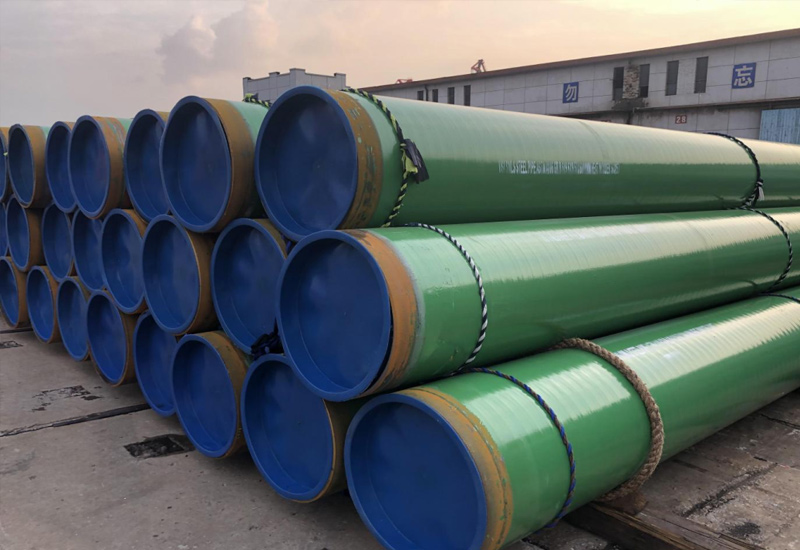HOT BLOG TAGS
DIN 30671
Specifications for Thermoset Coatings on Buried Steel Pipes
1. Scope and Technical Principles
1.1 Standard Definition & Evolution
DIN 30671 Carbon Steel Welding Pipe Coating SpecificationDIN 30671 DSHA ( German Institute for Standardisation )_DIN coating pipe standardDIN 30671 is the standard specification for Cement Mortar Lining for ductile iron pipes and fittings for water application published by the Deutsches Institut für Normung (DIN) in 1998. Its complete name is “Thermoset plastic coatings for buried steel pipe.” This standard organizes the material selection, manufacturing procedures, and quality control requirements for thermosetting coatings used for the exterior protection of steel pipe lines in underground and/or underwater services. It was developed during the Post-World War II rebuilding in the middle of Germany where in the immediate years before World War II, there was a market for a long-term creation of a corrosion prevention renovation material which in this case could be shown in re-lining gas works and district heating pipe
Corrosion Protection Mechanism:
| Function | Technical Basis | Performance Metric |
| Dielectric Barrier | Isolation from electrolytes | Volume resistivity >1×10¹⁶ Ω·m |
| Cathodic Compatibility | Synergy with CP systems | Disbondment radius ≤8mm @ -1.5V/CSE |
| Mechanical Adhesion | Anchor profile (50-100 μm) | Peel strength ≥50 N/cm (FBE) |
Service Life: >50 years in moderate soils (2-3× longer than asphalt coatings).
2. Material Systems & Requirements
2.1 Applicable Conditions
Media: Water, gas, crude oil, non-corrosive chemicals
Temperature: -30°C to +70°C (standard); up to 140°C (EN 10290)
Pipe Dimensions: DN 20 (1″) to DN 2000 (78″); WT ≥2.0 mm
Exclusions: Steam pipes (>120°C), UV-exposed sections, pH<4 or pH>10 soils
2.2 Coating Classification
| Coating Type | Thickness | Key Properties | Limitations |
| FBE | 300-500 μm | Adhesion ≥50 N/cm; CD ≤8mm @65°C/48h | Low flexibility |
| Polyurethane (PU) | 500-1000 μm | Impact ≥15J @23°C; rapid curing | UV degradation |
| PU-Asphalt | 1.0-3.0 mm | Water absorption <0.5%; high groundwater resistance | Environmental hazards (benzopyrene) |
3. Technical Requirements
3.1 Dimensional Tolerances
| Parameter | Requirement | Test Method |
| Coating Thickness | Min. 90% nominal; local min. 80% nominal | Magnetic gauge (4 pts/2m) |
| Holiday Detection | Zero defects @ 3.0 kV/mm | Spark tester (100% coverage) |
| Weld Coverage | Full coverage; +50% thickness allowed | Visual/UT verification |
| Cutback Length | 100±10 mm (uncoated for welding) | Caliper measurement |
3.2 Mechanical/Chemical Performance
| Test | Condition | Acceptance Criteria | Standard |
| Adhesion | Cross-cut | Grade 0-1 (no peeling) | ISO 2409 |
| Cathodic Disbondment | 65°C/48h/-1.5V vs CSE | ≤8 mm (FBE); ≤10 mm (PU) | ASTM G8 |
| Impact Resistance | -30°C | ≥5 J | ASTM G14 |
| Salt Spray | 2000 hrs | No blistering | ISO 7253 |
4. Quality Control & Testing
4.1 Mandatory Inspection Regime
Raw Material Certification:
FBE powder: Gel time 30-60 sec @120°C
PU: NCO content ±0.5%
Process Controls:
Surface prep: Sa 2.5 (ISO 8501-1); anchor profile 50-100 μm
Application:
FBE: 230±10°C electrostatic spray
PU: Substrate ≥ dew point +3°C
Final Verification:
Destructive Tests (per 4 hrs):
Peel adhesion
Cathodic disbondment
Bend test (2.5° bend, no cracking)
NDE:
Holiday detection (3.0 kV/mm)
UT thickness mapping (≤1m spacing)
Field Joint Requirements:
Peel strength ≥50 N/cm
Overlap width ≥50 mm
5. Engineering Applications
5.1 Case Study: Middle East Water Pipeline
Pipe: DN1200×12 mm with FBE (DIN 30671)
Challenge: Sandy soil +50°C temperature
Solutions:
Silane coupling agents → 40% adhesion increase
IR thermography (ΔT ≤±5°C during curing)
Validation: 85% adhesion retention after 15-yr accelerated aging
5.2 Delamination Failure (Sudan, 2015)
Failure: Coating blistering at field joints after 3 years
Root Cause:
Weld slag contamination (adhesion =18 N/cm)
Soil Cl⁻ >500 ppm → electrochemical corrosion
Corrective Actions:
Mandatory weld zone blasting (Sa 2.5)
Double-layer HDPE shrink sleeves
6. Standard Migration & Innovations
6.1 Current Replacements
| DIN 30671 Coating | EN Standard | Key Enhancements |
| Liquid epoxy | EN 10290:2004 | HT resistance to 140°C; self-healing |
| Polyolefin | EN 10289:2004 | Impact ≥20J @-30°C; 3PE systems |
6.2 Emerging Technologies
| Innovation Area | Technology | Performance Gain |
| Eco-Materials | Solvent-free epoxy | VOC reduction 95% |
| Bio-based PU (castor oil) | 30% renewable content | |
| Smart Coatings | Microcapsule self-healing | >80% damage recovery |
| Optical fiber sensors | Real-time strain/temperature monitoring | |
| Application Tech | Plasma pretreatment | Surface energy ↑70 dyn/cm |
| UV curing | Energy ↓40%; speed ↑3× |
7. Technical Data Summary
| Parameter | FBE Requirement | PU Requirement | Test Standard |
| Thickness | 300-500 μm | 500-1000 μm | DIN 30671 §6.2 |
| Adhesion (Peel) | ≥50 N/cm | ≥70 N/cm | ISO 4624 |
| Impact @23°C | ≥10 J | ≥15 J | ASTM G14 |
| Bend Test | No crack @2.5° | No crack @2.5° | ISO 1519 |
Implementation Notes:
For seawater exposure, supplement with DNV-RP-F106 (30 MPa hydrostatic resistance).
Hydrogen service requires H₂ permeability ≤0.5 mL/m²/day (per ISO 15105-1).
Carbon footprint reduction: Electric curing reduces CO₂ by 60% vs. gas-fired ovens.
Related Products
Share:
HOT TAGS
latest posts
- Introduction:Technology differences determine success or failure, and selection needs to be “precise”
- FBE Steel Pipes: Corrosion Protection Redefined
- DIN 30671: A Guide to FBE Coating for Steel Pipes
- A Guide to Structural Pipe: ASTM A500vsEN10219
- Weld Seam Integrity: A Deep Dive into LSAW vs. SSAW Pipe








